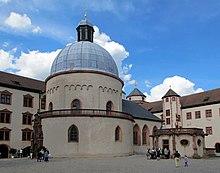Marienkirche, Würzburg


The Marienkirche, Würzburg (Saint Mary's Church) stands in the inner court of the Marienberg Fortress in Würzburg, Bavaria. The first Christian church at this location was built in 706 by Duke Hedan II. The structure of today's building can be traced back to the early 11th century. It is the oldest church in Würzburg and the oldest building in the fortress.
History
Duke Hedan II erected a small church in the year 706 during the early middle ages, which was dedicated to the virgin Mary. It was the cathedral and burial site of the Würzburg bishops until the remains of the martyrs Saint Kilian, Saint Colman und Saint Totnan were relocated to the new Würzburg Cathedral on the other side of the Main river in 788. The Marienkirche was officially transferred to the Saint Burkard monastery in 983.
When Heinrich I. was bishop, he built a new church at this location in the early 11th century, which potentially used some of the original structure and became a pilgrimage church. During the time of Konrad von Querfurt (died 1202) it became the church of the court (Hofkirche) of the dukes (Fürsts) of Würzburg in 1200. He made substantial changes to the building, when he increased the height of the cylindrical part and installed larger windows. After a fire in 1600, the building was re-erected by prince-bishop Julius Echter. He extendend the presbytery, built a parapet and put a lantern on top of the cuppola, which contains the church bells. The interior was modernised with plasterwork in renaissance style.
Portal
The ornamental portal was made from red sandstone, when Julius Echter was bishop, as indicated by his coat of arms. It displays figures of the apostles Saint Peter and Saint Paul, and above them the annunciation and finally the bishops Kilian und Burchard of Würzburg and a madonna.
Graves
Twenty grave plates remain in the centre of the church, which show reliefs of the Würzburg bishops. The church was the traditional burial place for the prince-bishops entrails. Their bodies were typically buried at the cathedral and their hearts at Ebrach Abbey.
-
Albrecht II. von Hohenlohe
died 1372 -
Sigismund von Sachsen
1440–1443 -
Anselm Franz von Ingelheim
1746–1749 -
Rudolf II. von Scherenberg
1466–1495 -
Lorenz von Bibra
1495–1519 -
Konrad II. von Thüngen
1519–1540 -
Konrad III. von Bibra
1540–1544 -
Friedrich von Wirsberg
1558–1573 -
Johann Gottfried von Guttenberg
1684–1698 -
Julius Echter von Mespelbrunn
1573–1617 -
Melchior Zobel von Giebelstadt
1544–1558 -
Johann Hartmann von Rosenbach
1609–1675 -
Konrad Wilhelm von Wernau
1683–1684 -
Johann Philipp Franz von Schönborn
1719–1724 -
Christoph Franz von Hutten
1724–1729 -
Adam Friedrich von Seinsheim
1755–1779
Literature
- Max Hermann von Freeden: Die Festung Marienberg. Würzburg 1982.
- Flachenecker, Götschmann, Kummer (Hrsg.): Burg. Schloss. Festung. Der Marienberg im Wandel. Mainfränkische Studien 78. Echter, Würzburg 2009. S. 168
- Festung Marienberg. Burgführer mit 41 Farbaufnahmen. Würzburg 2004.



















